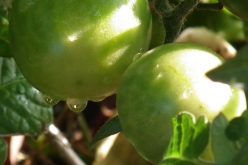 A Research Team From The UofA Show How, And Why It’s Important
A Research Team From The UofA Show How, And Why It’s Important
By Terrah Baker
There’s a lot of talk about food security these days. With new research showing even the wealthiest communities like NWA contain high amounts of child food insecurity, and even more that show the lack of nutrient-rich foods across the nation, there’s good reason.
In Arkansas there’s even more of a reason to be concerned. According to a report by the Department of Acriculture, Arkansas tops the food insecurity rankings — second in the nation, with 20 percent of Arkansans not knowing where their next meal will come from.
With all of the unused ground, non-edible landscaping taking up space, and talented people living in Fayetteville, researchers at the University of Arkansas think this type of suffering is unnecessary and by 2030 could change. But only if city planning takes a certain direction, and citizens become educated on what a Food City would mean.
Local Policy
As of now, one of the largest hurdles to making Fayetteville a Food City, helping to sustain or supplement its population, are code and development practices historically adopted by the city. In fact, some of the designs that were released in the “Agricultural Urbanism, Fayetteville 2030: Food City” report put out by the UofA Community Design Center research team are currently illegal.
“…Like a grow street or green boulevards; state highways aren’t allowed to have trees on them, they’re currently considered hazardous objects,” said Jeff Huber, assistant director of the UofA Community Design Center.
What the city can do, and has done on the Fayetteville dowtown square, is turn ornamental landscapes into productive landscapes. So instead of growing trees like Sweet Gum that have no real practical use, they’d grow apple trees.
An initial study in 2006 included the importance of a light-rail system to be included in future development of Fayetteville. The report showed that with current development strategies, the city would have 300 miles of new roads consuming about double the land by 2030. Even now, that’s a problem, Huber said. Fayetteville is running out of land to annex, which means these green, sustainable technologies look like the best option for maintaining a quality of life within the city.
To make a sustainable future a reality, Huber said the city has a role to allow for certain codes for proper development, especially with the large growth that’s hit NWA.
Educating The Public
The next large hurdle is education and stigma of eating food from public places, let alone including fresh, native and seasonal foods into every-day diets.
“One of the biggest things that we see in reintroducing agriculture into the landscape of the city, is providing agriculture literacy to the larger population,” Huber said.
Groups like Seeds That Feed, Apple Seeds, Tri Cycle Farms and Feed Communities (previously Feed Fayetteville) are working to educate community members on how to grow, harvest and cook fresh foods. Through programs like Cooking Matters, that takes place at Trinity United Methodist on Garland Avenue in Fayetteville every Saturday from 4 – 6 p.m., professionals like Joanna Pollock, former dietician for almost 10 years and instructor at the class, are working to educate the community at large on how to eat healthy foods.
“It’s an opportunity to educate the people in our community about healthy eating and cooking on a budget,” Pollock explained. “It’s not easy and it is something that people generally, now-a-days need education about because we’ve evolved into a fast food, high carbohydrate culture and gotten away from understanding how to eat a high nutritional-value meal on a budget.”
Training like this is also important because by 2030, the Design Center team suggests turning ornamental landscapes into productive foods capes will be an important part of feeding the community.
Energy Production
Another important part of Fayetteville sustaining itself through a food network, is looking at a low energy future — one that includes wind and solar energy and waste-to-energy districts. In the traditional farming and large agriculture business structure, waste can be harmful to land and stream ecology, but in the future, waste will be put into digesters to produce energy.
Many of the technologies these researchers discuss in their report already exist and are being used in other places, in third world countries and even right here.
“If you look at third world countries, they’re doing all this energy harvesting. The city has a biosolids program put on-line in a ‘no land waste’ water treatment program where they dried their solid waste and sold it back to the farmers. They’re already doing those kinds of things,” Huber explained.
Energy is currently very cheap in the U.S., making these technologies seem less appealing on a large-scale. Currently, the U.S. economy is run mainly on coal, nuclear, fossil fuels and natural gas which are far cheaper than what we see developed through anaerobic chambers. But this cheap accessibility won’t be a reality forever.
“By 2030, energy costs are estimated to double. If that’s the tipping point, then these systems become much more appealing,” Huber said.
Water Pollution
The plan also calls for using ecological and biological landscapes that would treat storm water runoff more closely to the natural filtering process. Right now, storm systems deal with quantity, not quality, leading untreated water containing pollutants and sediment to run into streams, rivers and lakes, causing problems such as excess algae growth; which in high concentrations can cause toxicity and oxygen depletion in the water.
Projects like the Rain Garden Academy hosted by the Illinois River Watershed offer education on why filtering storm runoff through an intentionally placed filtering system made only of native plants and natural soil inputs is helping keep our waterways clean. (Find out more about this project and how to build your own rain garden at www.irwp.org/conservation-and-restoration/rain-gardens)
It’s only been about 60 years, before WWII, since family farms from 50 to 250 acres were a regularity. Now a polarity exists between families and large-scale farms, and even small farms that are now more boutique in nature, servicing a niche population. But the plan for Fayetteville 2030 still includes these large, multi-thousand acre, monoculture farms.
“We’re not limiting any kind of farming. What this missing middle (urban agriculture) provides is to build the resiliency, to build local economy around agriculture,” Huber said.










